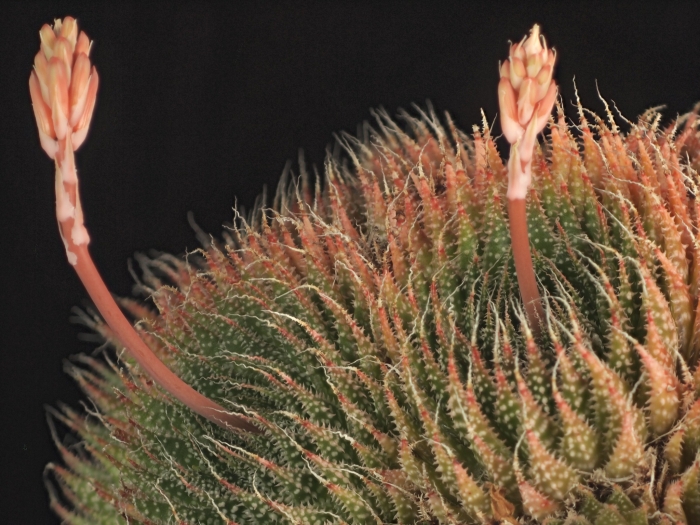Lace Aloe
(Aristaloe aristata)
Lace Aloe (Aristaloe aristata)
/
/

John Rusk
CC BY 2.0
Image By:
John Rusk
Recorded By:
Copyright:
CC BY 2.0
Copyright Notice:
Photo by: John Rusk | License Type: CC BY 2.0 | License URL: https://creativecommons.org/licenses/by/3.0 | Uploader: Josve05a | Publisher: Wikimedia Commons |


















Estimated Native Range
Summary
Aristaloe aristata, commonly known as Lace Aloe, is an evergreen succulent native to rocky outcrops and grassy slopes in the mountainous regions of Southern Africa. This plant typically forms dense rosettes of lanceolate, succulent leaves with bristly margins and a distinctive long thread-like tip (aristate). The leaves are arranged in a dense, imbricate pattern, giving the plant a full and textured appearance. Lace Aloe is notable for its nectar-rich, tubular orange to red flowers that bloom mainly in late fall to early winter, attracting birds, bees, and wasps. The flowers are showy and add a splash of color to the garden when many other plants are not in bloom.
Lace Aloe is valued for its ease of maintenance, drought tolerance, and ability to withstand cooler temperatures down to -7 °C, which is unusual for succulents. It is commonly used in rock gardens, succulent collections, and as a potted houseplant. The plant’s ability to produce numerous offsets makes it easy to propagate and share with other gardeners. It has earned the Royal Horticultural Society’s Award of Garden Merit, highlighting its desirability for cultivation. In the garden, it thrives in full sun to part shade and requires well-drained soil. While it can tolerate a range of rainfall systems, it is important to avoid waterlogging to prevent root rot.CC BY-SA 4.0
Lace Aloe is valued for its ease of maintenance, drought tolerance, and ability to withstand cooler temperatures down to -7 °C, which is unusual for succulents. It is commonly used in rock gardens, succulent collections, and as a potted houseplant. The plant’s ability to produce numerous offsets makes it easy to propagate and share with other gardeners. It has earned the Royal Horticultural Society’s Award of Garden Merit, highlighting its desirability for cultivation. In the garden, it thrives in full sun to part shade and requires well-drained soil. While it can tolerate a range of rainfall systems, it is important to avoid waterlogging to prevent root rot.CC BY-SA 4.0
Plant Description
- Plant Type: Subshrub, Succulent
- Height: 0.5-1 feet
- Width: 1-2 feet
- Growth Rate: Moderate
- Flower Color: Orange
- Flowering Season: Summer, Winter
- Leaf Retention: Evergreen
Growth Requirements
- Sun: Full Sun, Part Shade
- Water: Low, Very Low
- Drainage: Fast
Common Uses
Bee Garden, Bird Garden, Deer Resistant, Drought Tolerant, Fire Resistant, Groundcover, Hummingbird Garden, Low Maintenance, Potted Plant, Rock Garden, Street Planting
Natural Habitat
Rocky outcrops and grassy slopes in the mountainous regions of Southern Africa
Other Names
Common Names: Guinea-Fowl Aloe, Torch Plant
Scientific Names: , Aloe aristata, Aristaloe aristata, Aloe aristata var. parvifolia, Aloe ellenbergeri, Aloe longiaristata, Aloe aristata subsp. leiophylla, Aloe aristata subsp. parvifolia, Aloe aristata var. leiophylla, Aloe aristata var. parviflora
GBIF Accepted Name: Aristaloe aristata (Haw.) Boatwr. & J.C.Manning